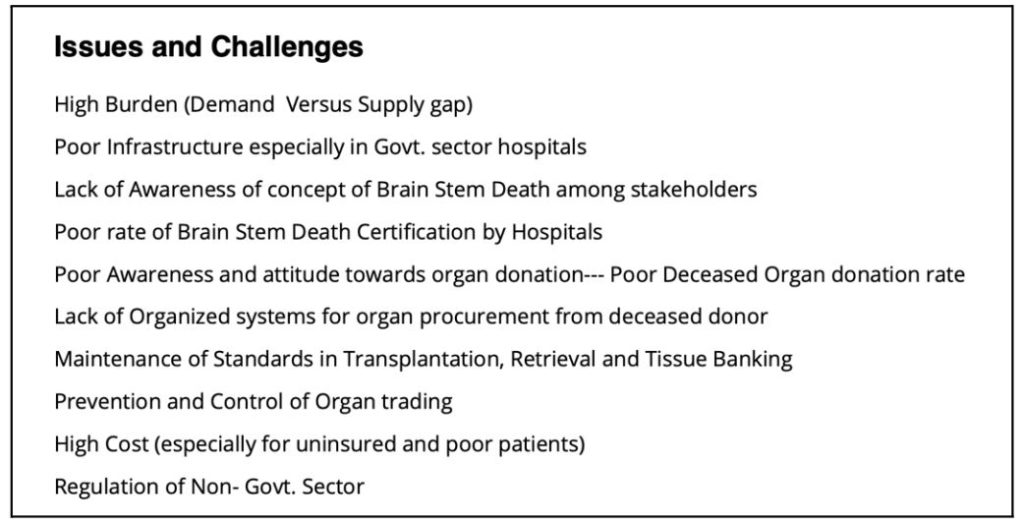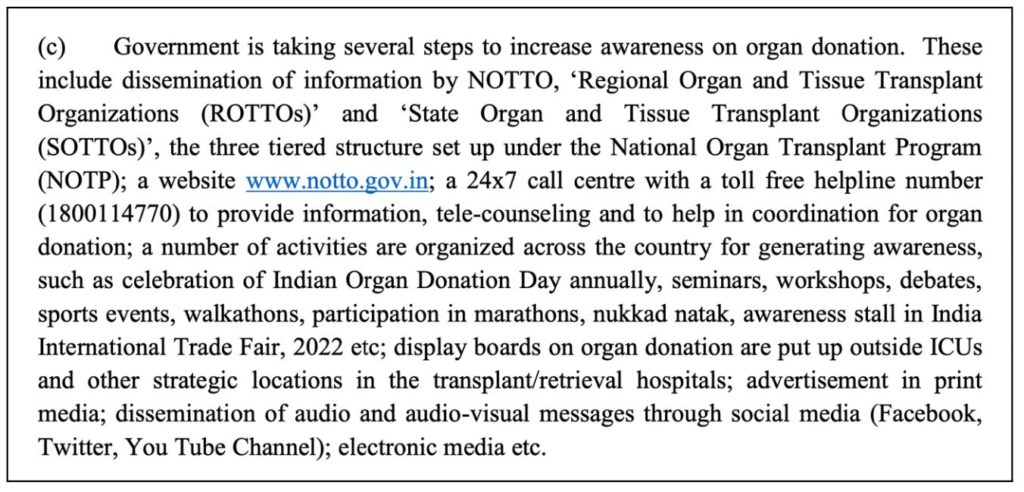In India, organs can be donated either by the living donors or from the deceased. Like in many countries, there is a wide gap between the supply & demand. Data from 2016 & 2021 indicates that four states account for 53% of the organ donations reported from across the country. Proportion of living donors is far greater than the deceased.
The first ever successful organ transplant was done in 1954, in the USA, when a healthy kidney was transplanted to an identical twin who had chronic kidney failure. Over the decades, the technology assisting organ transplant has vastly improved with successful transplants of many other organs.
Organ transplants have proved to be lifesaving in many critical situations caused due to organ failure. However, the concept of organ donation still does not have a wider acceptance and is largely overlooked. The shortage of organs is a universal problem and India is also one of the countries where there is a wide gap between those who need transplants and the organs that are available. In other words, there is a huge supply-demand gap. The data provided by the Directorate General of Health Services (DGHS) about the ‘National Organ Transplant Programme’ highlights this situation.

In India, the Transplantation of Human Organs Act, 1994 (THOA) was enacted to provide a standard legal framework relating to organ donation and transplantation as well as to prevent illegal commercial dealings in human organs. This was further reformed and amended, with the enactment of the Transplantation of Human Organs (Amendment) Act 2011. Factly’s explainer on Organ donation can be found here.
So, what have been the trends in organ donation in India? We look at the numbers based on the data provided by the Government of India in the parliament.
Organs donated in 2021 back to pre-pandemic levels after a fall in 2020
Trends in recent years indicated a gradual increase in the number of organs donated every year.
As per a response in Lok Sabha, there were a total of 9,581 donations in 2017. This was higher than the number in 2016 when it was 9046, based on an answer in Rajya Sabha. The numbers increased in successive years.
However, there was a fall in 2020, when the total number of organ donations was only 7519 compared to 12746 in 2019. News reports and various sources indicate that the COVID-19 pandemic was the prime reason for this fall. The limitations around movements, hospitals infrastructure occupied with tackling the pandemic, etc. could have influenced the number of organ transplant operations in 2020. In 2021, the number increased to 12387, which is close to the pre-pandemic level. It is also believed that this higher number in 2021 could be due to the many pending operations from 2020 being pushed to 2021.
Increasing proportion of organ donations from living donors
Organs can be donated by either the living donors or from the deceased. Living donors include both related donors and unrelated donors who are emotionally attached to the one receiving the organ. The organs that living donors can donate include – Kidney, a portion of the Liver/lung/pancreas.
In India, Brain Stem death is categorised as a legal death and organ donation from such deceased can be done. The organs include – Eyes, Kidneys, liver, lungs, pancreas, uterus, nerves, etc.
In India, trends indicate that the organ donation from the living is higher than from the deceased. In fact over the years, the trends indicate an increasing proportion of organ donations from the living. In 2016, around 75% of the organs donated were from living donors. Out of the 9046 recorded organs donated, 6781 were from the living donors and the remaining 2265 were from the deceased. Except for 2018, the proportion of organs donated by living donors out of the total has increased year-on-year. During the pandemic hit in 2020, the share of living donors was around 86%, and this remained the same even in 2021.
Despite a law in place which facilitates and encourages organ donation from deceased persons, the overall numbers remain low. In fact, the actual number of organs donated by the deceased show a decline despite an overall increasing trend in the total number of organs donated.
4 states make up more than 50% of the total organ donations
The trends in organ donations are not only skewed between living and deceased but also geographically. Few states contribute towards a major share of the organ donations in the country. Geographically, it is higher in the Southern and Western states of the country.
If the cumulative total of the 6-year period (2016-2021) is considered, Delhi has the highest number of organ donations with 11,181, out of which a major share of 10,778 are from living persons. Delhi being the capital city and a major medical hub of the country is a factor in the higher number of transplant surgeries being done, which in turn results in higher organ donations in the country.
Tamil Nadu is the next with around 10 thousand donations in the last six years. Compared to Delhi, the ratio of organ donations from living donors and deceased is better with 6.9 thousand from living and the rest from deceased. Maharashtra & Telangana are next on the list of most organ donations. These four states together account for around 53% of the donations. It ought to be noted that these states are home to major cities like Chennai, Hyderabad, Mumbai, Pune, etc., which are the medical hubs that attract patients from within the states and from all over the country. The presence of hospital infrastructure in these cities could be the major reason for this skew.
The other two southern states of Karnataka & Kerala along with Gujarat, Bengal & Haryana are among the states with a higher number of organ donations. In most of the states, the trends conform to the overall trends i.e., the donations from the living donors are proportionally higher than that of the deceased and there is a fall in the donations during 2020, which increased in the subsequent year.
There are exceptions to the general trend
Data does throw up a few exceptions to the general trend. In the case of Andhra Pradesh, during the period 2016-2018, the number of organ donations from the deceased was higher than compared to from living donors contrary to the common trend in other states. During these years, 374 organ donations were from the deceased, while it was 102 from the living. It ought to be noted that in each of these three years, the donations from the deceased were higher. However, the trend changed in 2019 and conforms to the larger trend of donations from living donors being higher than from the deceased.
Prior to 2020, there was no record of organ donations in Chhattisgarh. However, in 2020, 213 donations were from living persons. This increase during the pandemic year is an outlier to the common trend across the states. The number fell to 32 in the next year.
A common trend observed in 2021 is that most of the states have an increased proportion of organ donations from the living. This is the case even among states like Tamil Nadu, which earlier had a better distribution between living donors & the deceased.
Need to increase the organs donated from the deceased
Comprehensive data on the specific organ donated by the living is not available from publicly accessible official government sources. This information would throw further light on the nature of the requirement for organs and the reliance on them from the living.
Most of the cases where organs are donated from the living donor are a result of the requirement which arose rather than a voluntary act of donation. On the other hand, the organs donated from the deceased are voluntary.
In view of the increasing gap between the organs required for transplant and organs donated, it is extremely important that initiatives are taken to encourage organ donation from the deceased.
The DGHS website highlights a few of these challenges.

In its response in Lok Sabha, the government highlighted the various steps taken towards increasing the awareness of organ donation. Most of the steps are towards wider dissemination of the information through various media. The impact of these campaigns remains to be seen.

Featured Image: Organ Donations


